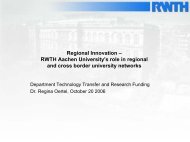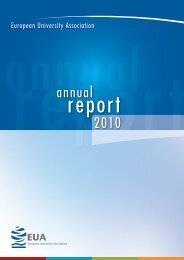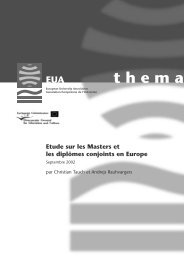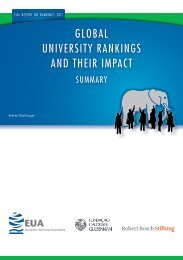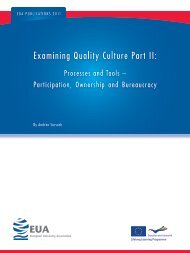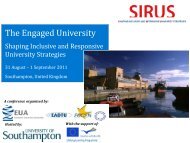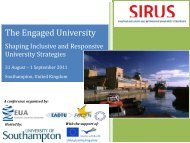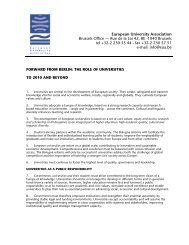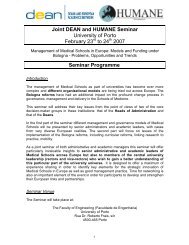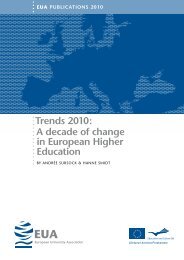Beiträge zur Hochschulforschung - European University Association
Beiträge zur Hochschulforschung - European University Association
Beiträge zur Hochschulforschung - European University Association
Create successful ePaper yourself
Turn your PDF publications into a flip-book with our unique Google optimized e-Paper software.
34<br />
Thomas Estermann, Enora Bennetot Pruvot<br />
The other specificity of the university is its geographic location, at the periphery of<br />
the Dutch decision-making centres, but strategically placed to attract both German<br />
and Belgian students, which quickly became key target groups for the university. The<br />
increased presence of “regional” international students and staff has also pushed<br />
Maastricht to become a fully bilingual university. This early orientation towards inter-<br />
nationalisation has helped the university to further build on this to identify “focus”<br />
countries outside the EU and create an integrated approach to international student<br />
recruitment.<br />
Importantly, the Dutch government stopped subsidising places for non-EU students<br />
in 2006, which triggered the implementation of differentiated fees for this part of the<br />
student population. This has resulted in significant risk mitigation for the university as<br />
a large part of its students (about 40 per cent) does not depend on financial support<br />
from the Duch government.<br />
These developments are therefore underpinned by a consistent strategy to which the<br />
university leadership is strongly committed. This in turn is supported by coherent fi-<br />
nancial planning driven by expectations (such as the reduction of public funding avail-<br />
able and the need to enhance additional funding).<br />
7.2.2 Loughborough <strong>University</strong><br />
Loughborough <strong>University</strong>’s income generating activities strongly underpin the institu-<br />
tion’s ethos and academic mission.<br />
As a financially sound university, Loughborough <strong>University</strong>’s financial target is to de-<br />
liver a 3 per cent surplus on an annual basis. However, on the basis of expectations<br />
regarding cuts in public funding, the university’s management is engineering a large<br />
operation aiming at reshaping the institution into more cost-effective and academic-<br />
focused structures. This includes rationalizing the number of academic structures into<br />
larger cost centres (merging departments) and looking for saving and investment<br />
opportunities across the university’s services. Expected funding cuts have neverthe-<br />
less not been driving the agenda for income diversification, as a long-time target has<br />
been to increase, in absolute terms, public funding while reducing it as a proportion<br />
of LU’s total income.<br />
This is strongly embedded in the institution’s budget process through the direct involve-<br />
ment of the deans in the drafting of the development plans of their faculties. The deans<br />
are asked to identify and prioritise saving and investment opportunities. This process<br />
is “locked in” by assuming a certain level of enterprise and fundraising growth in all<br />
development plans. Transparency is also key to success, while important work has<br />
<strong>Beiträge</strong> <strong>zur</strong> <strong>Hochschulforschung</strong>, 33. Jahrgang, 2/2011



